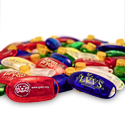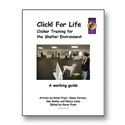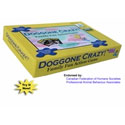Kenneled dogs exhibit wild behavior upon entering or leaving the kennel because they need company. Our instinct is to respond to this need. It flatters us and triggers our sympathy. However, offering no response or actually withholding our entry is the kindest action you can take. Nobody has taught most shelter dogs how to greet people, so they greet us like they would other dogs - they touch, sniff, jump up, lick, try to wrestle and play. To be successful when adopted they have to learn self-control. We can give them a real start by how we handle our entry and exit from the kennels or outside pens.
Kennel procedure
- Approach the dog's kennel or outside pen.) Mostly likely the dog will be jumping and/or barking. (If you get to the kennel and the dog keeps all four paws on the floor and is not barking go to #2. Just stand there saying nothing, and give him ten seconds to stop barking and have all four paws on the floor. If he can't control himself, turn your back to the dog and step away. Keep your head turned enough to watch for good behavior. When he is quiet and has four-on-the-floor, click, turn, and toss the kibble into kennel. Remain facing the kennel door and step toward it. Give him 10 seconds to get control of himself (four-on-the-floor and no barking). If the dog remains calm go to #2; if the dog jumps or barks turn your back and step away. It may take only a few times of doing this, or it may take many repetitions, but the dog will learn to control his behavior. You do not go to the next step until the dog is quiet and standing (or sitting). If the dog isn't "getting it", try moving to the next kennel and begin clicking that dog. Competition is frequently a good motivator. Work the neighbor dog for a few clicks, and then move back to the first dog again. They do learn by watching what works for another dog.
- Reach for the door of the kennel; open it using your body to block any exit by the dog. Walk in with your shoulder turned into dog and have food in the hand closest to the dog, letting him smell it and nibble at it. You aren't actually feeding any of the food until you can shut the kennel door behind you. At any point if the dog has lost control, you back out, shut the door and go back to step #1. You are never angry; you are a calm immovable force. You are putting the dog in charge of getting what he wants if he is calm, because that is all you will reinforce.
- Once in the kennel, pat and touch the dog quietly; hook the leash to the collar. If the dog jumps or barks stand with your foot on the leash so the dog can't jump on you, and then turn your back. Wait for calmness, turn back around and offer the food reward from your hand if you can, or drop it on the floor if the dog is nippy. Remember to look for any opportunity to click and then treat the dog for even the smallest moments of calmness -like four on the floor, eye contact, looking at you, moving away from the kennel door, etc. Once in the kennel and when the dog is calm, put on the Gentle Leader. Be sure to clip the leash to the ring on the GL and to the flat collar ring.
- Now you are ready to exit. The dog should be sitting or standing as you move to the door. If he can't be calm, turn, and walk away from the door with the dog and wait till his self-control returns, then reinforce (click and give a treat), and try again. You should precede the dog through the door. If he won't let you, turn around walking back into the kennel, again wait for calm, then reinforce and try again. Once you lead through the door, proceed outside quickly.
The more clicks followed by treats, the faster the dog will get it. Teach your kennel staff and volunteers to click for the smallest improvements, rather than holding out for a long calm sit. If you wait for too much and for too long the dog may lose interest.
Contact Dee Ganley, UVHS Training Center Manager and Behavior Counselor with any questions at 603-488-6888 ext. 103 or e-mail dee [at] UVHS [dot] org. For more information on the Upper Valley Humane Society their web site is at www.UVHS.org.
Copyright © 2002 Upper Valley Humane Society







Advice...
Train him to go into the kennel when you don't need him to be there. Since he already rests in there and feels comfortable you can wait until he goes in when he's calm, give him a click and treat. Eventually you can associate a 'kennel up' command or something of the sort.
You might also want to practice opening and closing the door when he is just laying down for a nap or just waking up (so you don't interrupt his sleep) that way he can get used to it and not be so reactive.
But really, the most important part is the first one. Whenever we need dogs to do something we have to train the behavior when it's not important, otherwise everyone is frustrated.
Good Luck,
Kelly
HELP
When my dog is hyper and we need to put him in his crate he will not go in because he wants to play. I try picking him up and putting him in but before I get a chance to close the door he darts out. He goes in fine when he is tired or wants to lay down.
What should I do? Do you have any advice.
Lyd
Post new comment